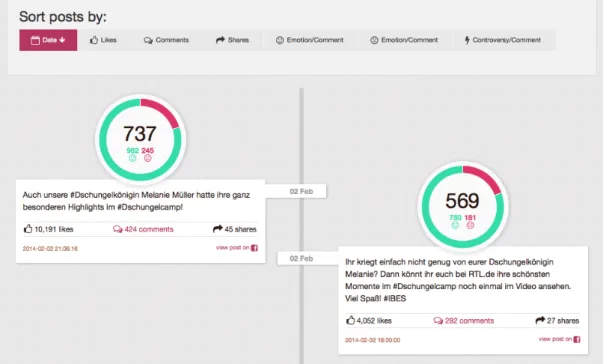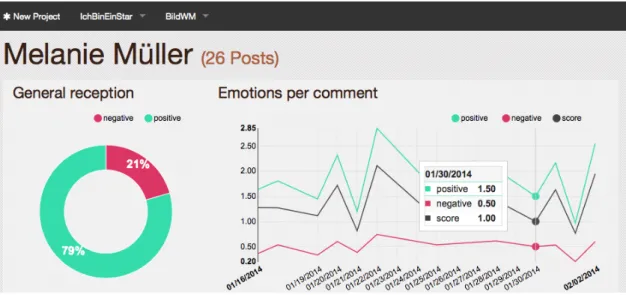Sentilyzer – A Mashup Application for the Sentiment Analysis of Facebook Pages
Hartmut Gl ¨ucker, Manuel Burghardt, and Christian Wolff Media Informatics Group
Institute for Studies in Information and Media, Language and Culture University of Regensburg
firstname.lastname@ur.de
Abstract
We present Sentilyzer, a web-based tool that can be used to analyze and visualize the sentiment of German user comments on Facebook pages. The tool collects com- ments via the Facebook API and uses the TreeTagger to perform basic lemmatiza- tion. The lemmatized data is then analyzed with regard to sentiment by using theBerlin Affective Word List – Reloaded(BAWL-R), a lexicon that contains emotional valence ratings for more than 2,900 German words.
The results are visualized in an interactive web interface that shows sentiment anal- yses for single posts, but also provides a timeline view to display trends in the senti- ment ratings.
1 Introduction
Social media platforms such asFacebookorTwit- terchurn out vast amounts of user generated con- tent. This data can be analyzed with regard to subjective information – i.e. people’s emotions, attitudes, opinions, and sentiments – to monitor specific topics or detect trends. Such analyses are typically referred to assentiment analysisoropin- ion mining[Liu, 2012].
This article introducesSentilyzer, a web appli- cation for the sentiment analysis and visualiza- tion of user comments on Facebook pages. The comments are lemmatized and sentiment scores are clustered according to previously defined key- words. The results of the sentiment analysis are presented to the user in an interactive web inter- face. The rest of the article is structured as fol- lows: Section 2 gives an overview of the tech-
nical realization ofSentilyzer; section 3 presents the main features and basic functionality of the tool. Section 4 concludes the insights of a first case study that has been conducted with Senti- lyzer, and also describes the next steps in the de- velopment of the prototype.
2 Technical realization of Sentilyzer Sentilyzeris realized by means of a client-server architecture that requires an Apacheserver with PHPand aMySQLdatabase. Lemmatization and sentiment analysis are realized on the server-side by usingJava. Sentilyzer can be categorized as a mashup application, as it integrates a number of freely available, third-party components in a common web interface:
Data crawler and web interface: Facebook Graph API (application programming interface for crawling Facebook data)1, Foundation 5.1 (HTML template frame- work)2,Isotope.js 2.0(JavaScript library for element sorting)3,Laravel 4.1 (PHP frame- work for web applications)4, NVD3.js 1.1 (JavaScript library for facilitated creation of graphs based on theD3.jslibrary)5
Lemmatizer and POS tagger: TreeTagger (POS tagger and lemmatizer for German)6,
1https://developers.facebook.com/docs/
graph-api; all URLs mentioned in this paper were last accessed July 10, 2014
2http://foundation.zurb.com/
3http://isotope.metafizzy.co/
4http://laravel.com/
5http://nvd3.org/
6http://www.cis.uni-muenchen.de/
TT4J(Java wrapper for TreeTagger)7 Sentiment lexicon: Berlin Affective Word List –
Reloaded(BAWL-R)8
3 How Sentilyzer works: Basic functionality in five steps
The basic functionality of Sentilyzercan be bro- ken down into five basic steps that are explained in more detail in the following sections.
3.1 Preliminaries: Project and database setup (Step 1)
Before Sentilyzer can analyze the sentiment of Facebook comments, the user needs to define the basic project details via an XML configuration file. First, the name of the Facebook page that is to be analyzed needs to be specified. Users can also define a timeframe (start and end date) for posts from this page to be included in the analysis. As Sentilyzer allows the user to dis- play aggregated sentiment scores for clusters of comments as well as sentiment trends for such clusters throughout time, it is important to spec- ify the parameters for these clusters in advance: It is possible to define arbitrarytimelines(=clusters of posts) containing only posts that include or ex- clude certain keywords. The following example creates a timelinenamed ”Michael Wendler” for all posts that contain the keywords ”Michael” or
”Wendler”, but not ”Michael Schumacher”.
<timeline>
<name>Michael Wendler</name>
<includePostsWithKeywords>
<keyword>Michael</keyword>
<keyword>Wendler</keyword>
</includePostsWithKeywords>
<excludePostsWithKeywords>
<keyword>
Michael Schumacher
</keyword>
</excludePostsWithKeywords>
</timeline>
˜schmid/tools/TreeTagger/
7https://code.google.com/p/tt4j/
8http://www.ewi-psy.fu-berlin.de/
einrichtungen/arbeitsbereiche/allgpsy/
BAWL-R/index.html
After a new project has been created accord- ing to the parameters specified in the XML- configuration file, a corresponding database struc- ture is created automatically by the tool.
3.2 Crawling the Facebook page (Step 2) In the second step, the crawler component col- lects all posts and comments from the previously specifiedFacebookpage via theFacebook Graph API. The following information for posts and as- sociated user comments is stored in the relational database:
Posts: message text,number of likes,number of comments, number of shares, date of publi- cation
User comments: author name, message text, number of likes,date of publication
3.3 Clustering of posts (Step 3)
In this step the tool creates timeline clusters of posts according to the keywords that have been specified in Step 1. This clustering of posts allows the user to compare aggregated sentiment scores of different timelines (e.g. for different celebri- ties) in the final step.
3.4 Lemmatization and calculation of sentiment scores (Step 4)
Step 4 contains two important sub-steps: First, the message texts are lemmatized to make them avail- able for automatic sentiment analysis. Sentilyzer utilizes an existing lemmatizer for German lan- guage, theTreeTagger[Schmid, 1994].
Second, the lemmatized comments are com- pared with a lexicon that contains sentiment scores for different words. For the German lan- guage, there are only few resources that can be used as a sentiment lexicon. We identified the Multi-layered Reference Corpus for German Sen- timent Analysis(MLSA) [Clematide et al., 2012]
and the Berlin Affective Wordlist – Reloaded (BAWL-R) [V˜o et al., 2006, 2009] as appro- priate resources for this project. Eventually, we decided to use the BAWL-R lexicon, as it provides more sentiment annotations for single words (over 2,900 words) than MLSA (about 820 words), with the latter being more focused on multi-level sentiment annotation that includes larger units such asphrasesandsentences.
Figure 1: The example shows the original comment and the lemmatized version as well as the BAWL-R sentiment score for a matching word.
The BAWL-R lexicon provides scores foremo- tional valence9, ”ranging from –3 (very negative) through 0 (neutral) to +3 (very positive)” [V˜o et al., 2009, p. 535]. The positive and negative
9BAWL-R also contains information aboutarousaland imageability. This additional information was not utilized in the current prototype, but could be supplemented in a later version of the tool.
values of words that match the BAWL-R lexicon are summed up to an aggregated sentiment score for each comment (cf. Figure 1).
3.5 Visualization of sentiment scores (Step 5) In the last step, the results are visualized in an interactive web interface. The results are orga- nized according to thetimelines that were speci- fied in Step 3. All posts of atimelineare displayed chronologically and can be sorted with respect to different parameters such as positive / negative sentiment, number of comments, etc. (cf. Fig- ure 2). Alongside the message content, number of likes, number of comments, number of shares andpublication date, the tool displays the aggre- gated sentiment score for all comments that are associated with a post. The tool also provides an aggregated sentiment score for all comments as- sociated with a specific timeline as well as a view that shows sentiment trends for comments to dif- ferent posts in the course of time (cf. Figure 3).
4 Conclusions and outlook
Sentilyzerserves as a proof of concept for a tool that is able to crawl user comments from Face- bookpages, toanalyzetheir sentiment, and tovi- sualize the results in a user-friendly and interac-
Figure 2: Posts with aggregated sentiment scores for all associated comments. The posts are displayed chrono- logically be default, but can be sorted by a number of different parameters as well.
tive web interface. As the tool utilizes a number of freely available APIs and tools as well as an existing sentiment lexicon for German, it may be considered amashupapplication. By using third party components for natural language processing and sentiment analysis of social media data it also becomes obvious that existing resources are not optimized for the specifics of computer-mediated language, e.g. specialized vocabulary and ”loose”
orthography. We are planning to create a crowd- sourced lexicon with lemmatized forms and sen- timent scores for computer-mediated language in an upcoming research seminar on sentiment anal- ysis, thus hopefully improving the current weak- nesses of the prototype.
Nevertheless,Sentilyzerhas already been used successfully to analyze the perception of candi- dates from the German reality show ”Ich bin ein Star - Holt mich hier raus (2014)” on the of- ficial Facebook page10. The large number of user comments compensated for most of the erro- neous lemmatizations and sentiment scores, and could be used successfully to show aggregated sentiment scores and sentiment trends through the course of the TV show.
A live demo ofSentilyzerwith sentiment visu- alizations for all candidates is available athttp:
//dh.wappdesign.net/. We are currently
10https://www.facebook.com/
IchBinEinStar
working on a documented version of the appli- cation that will be available viaGitHubfor local installation. In the long-term, we are planning to hostSentilyzeras a web service.
References
Simon Clematide, Stefan Gindl, Manfred Klen- ner, Stefanos Petrakis, Robert Remus, Josef Ruppenhofer, Ulli Waltinger, and Michael Wiegand. MLSA-A Multi-layered Reference Corpus for German Sentiment Analysis. In Proceedings of LREC ’12, pages 3551–3556, 2012.
Bing Liu. Sentiment Analysis and Opinion Min- ing. Morgan & Claypool, San Rafael, CA, 2012.
Helmut Schmid. Probabilistic part-of-speech tag- ging using decision trees. InInternational Con- ference on New Methods in Language Process- ing, pages 44–49, Manchester, UK, 1994.
Melissa L H V˜o, Arthur M Jacobs, and Markus Conrad. Cross-validating the Berlin Affective Word List. Behavior research methods, 38(4):
606–609, 2006. ISSN 1554-351X.
Melissa L-H V˜o, Markus Conrad, Lars Kuchinke, Karolina Urton, Markus J Hofmann, and Arthur M Jacobs. The Berlin Affective Word List Reloaded (BAWL-R). Behavior research methods, 41(2):534–538, 2009. ISSN 1554- 351X.
Figure 3: Aggregated sentiment score for all comments associated to a specific timeline and sentiment trend in the course of time.

